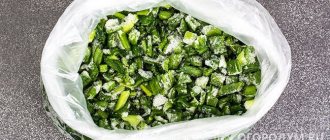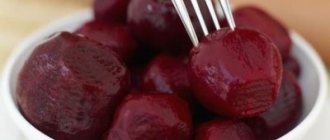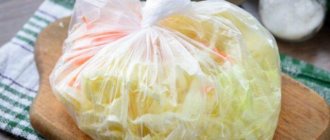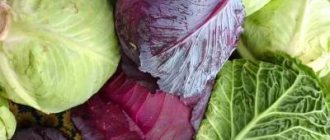- Whole heads of cabbage
Cabbage is one of the most popular types of vegetables known since Antiquity. Initially it grew in the Mediterranean, from where it spread almost throughout the world. It is known that the ancient Greeks and Romans grew several varieties of the crop. Europeans became acquainted with it during the early Middle Ages, and in Rus' they began to cultivate it from the end of the 11th century. Modern housewives often wonder whether and how to properly freeze white cabbage in order to simplify its storage and always have the necessary supply on hand.
Among the variety of species, white cabbage is rightfully considered a traditional Russian vegetable, from which several hundred dishes can be prepared
Beneficial features
The vegetable has excellent taste, nutritional, and medicinal properties and is used in folk medicine. Contains many amino acids, vitamins: C (up to 50 mg per 100 g), P, group B, which affect the functioning of almost all organs and support the immune system, and vitamin U, rare in nature, helps treat gastric and duodenal ulcers.
The presence of easily soluble sugars - glucose and fructose, a small amount of sucrose and starch makes cabbage an indispensable component of dietary and diabetic nutrition. Enzymes and potassium salts have a beneficial effect on digestion, fiber stimulates intestinal motility.
Is it possible?
Is it possible to freeze white cabbage? The question is logical, since cabbage really does not like the cold. When frozen, cabbage loses its crunch and beautiful appearance. She becomes lethargic and soft . That is why it is important to comply with harvesting deadlines.
This means that you can still freeze cabbage, but after defrosting it is not suitable for everything.
Where you need crispy cabbage (salads, for example), you will have to get it from the underground or buy it at the market. For other dishes, for example, frozen cabbage is also suitable for cabbage soup.
Shelf life
Frozen cabbage is consumed before the beginning of summer, and with the appearance of the first harvest of young vegetables, semi-finished products are disposed of. The optimal storage temperature is from -15 to -18°C. Thawed cabbage cannot be re-frozen or stored in the refrigerator.
Advantages and disadvantages
Before choosing freezing as a method of storing cabbage for the winter, it is worth understanding its usefulness. It is worth noting that it is becoming an increasingly popular way of preserving vegetables along with drying.
Pros of freezing :
- cabbage retains all its beneficial properties;
- always kept at hand;
- stored as a finished semi-finished product;
- long shelf life of cabbage;
- Defrosts quickly and is immediately ready for cooking.
Minuses:
- cabbage becomes soft and is not suitable for salads;
- the appearance deteriorates and becomes unattractive;
- takes up space in the freezer;
- Doesn't crunch after defrosting.
Like any method, freezing cabbage for the winter has both pros and cons. The main advantage of this method is that the vegetable retains all its beneficial properties . The main disadvantage is the loss of the original appearance.
You can learn about the pros and cons of freezing broccoli for the winter, as well as whether it is possible to freeze Brussels sprouts for the winter from our materials. Freezing is one of the ways to store cabbage at home, and you can read about how to store cabbage in a cellar or basement on our website.
What are the benefits of cabbage and what varieties are suitable for freezing?
Cabbage has the following benefits for the body:
- Has anti-inflammatory properties.
- Benefits the intestinal tract, stimulating its work and normalizing internal processes.
- It helps well with scurvy due to its high content of vitamin C.
- Removes excess cholesterol from the body.
- Used to prevent diseases associated with inflammation of the heart and kidneys.
You can freeze:
- cauliflower;
- broccoli;
- white cabbage;
- kohlrabi.
For freezing, you should choose a product that meets the following conditions:
- there are no traces of rot or mold on the product;
- You should not freeze vegetables that have become overripe. Its usefulness and taste when defrosted will be worse than usual;
- The best option is to freeze young vegetables. They tolerate the defrosting process well.
Note! Use for freezing a product that was picked from the garden no later than 2 days ago.
Rules for freezing cabbage for the winter
How to freeze white cabbage for the winter? Freezing is a simple process. Even a novice housewife can handle it. However, it also has its own characteristics.
Cabbage needs to be prepared for frozen storage.:
- choose good, whole, correctly formed, strong heads of cabbage;
- make sure there is no rotting, damage by insects and insects themselves;
If a caterpillar or slug is hiding among the cabbage leaves, then most likely they will be frozen along with the cabbage. During subsequent defrosting and cooking of the dish, insects can get into it. This is extremely unpleasant. It is worth inspecting the cabbage very carefully before freezing. - remove the top leaves;
- rinse the cabbage in cool water;
- dry with a towel.
Some housewives recommend blanching before freezing; this procedure (short-term heat treatment) will destroy harmful enzymes.
Read about the rules for freezing cauliflower at home on our website.
Preparation
It is best to freeze fresh cabbage of proven late varieties: “Amager”, “Vyuga”, “Leader”, “Moskovskaya late”, “Podarok”, “Sugarloaf”, etc. At the preparation stage, it is enough to follow simple rules:
- choose dense, strong heads of cabbage;
- inspect for diseases and pests (slugs, caterpillars);
- remove the top wilted leaf;
- trim the bottom of the stalk;
- wash thoroughly;
- let the water drain, dry with a paper towel.
It is more convenient to wash small heads directly in a colander under cold running water.
Methods
Depending on further use, cabbage is frozen in several ways. How to freeze white cabbage in the freezer for the winter?
A whole head of cabbage
This method is ideal for further preparation of cabbage rolls .
If you prepare them from such cabbage, there is no need to pre-boil and soften the leaves. Once frozen, they will become soft and immediately ready for filling.
To freeze whole cabbage, you need to cut out the stalk , peel, rinse, and dry the cabbage. Wrap the prepared cabbage in cling film and place it in the freezer.
To defrost, simply transfer the cabbage to the refrigerator, it will thaw a little and become ready for use.
Leaves
Cabbage is also frozen this way, mainly for making cabbage rolls . The procedure is as follows:
- Prepare cabbage: wash, remove top leaves;
- remove the stalk;
- boil a little;
- disassemble into leaves;
- put them in bags;
- to freeze.
After defrosting, you can immediately prepare cabbage rolls from these leaves. Fast and convenient.
Shredded
The most popular freezing method. This cabbage can be used in cooking borscht and stewing . To freeze shredded cabbage you need:
- prepare the heads of cabbage: wash, remove the top leaves, dry;
- chop cabbage;
- put into plastic bags;
- to freeze.
Shredded cabbage can be frozen not only separately, but also in combination with other vegetables . Thus, excellent blanks are obtained.
How to freeze
Fresh cabbage is a source of vitamins and nutrients, but there are no less of them in the sauerkraut product and in the stew. If there is a large amount of prepared food, it is also put in the freezer.
Fresh
Fresh cabbage is stored at sub-zero temperatures for subsequent preparation of first courses, side dishes, and casseroles. Other fresh vegetables are added to the vegetable mixture - carrots, beets, bell peppers, and herbs. To defrost, simply place the bag on the refrigerator shelf or kitchen counter.
Pickled
Lovers of cabbage soup or aromatic pickled snacks store cabbage in this form. The product is fermented in any way until it is completely ready. Glass jars are not suitable for freezing it, as they burst at sub-zero temperatures.
A convenient way is plastic containers or leak-proof plastic bags. Sauerkraut will not lose its beneficial properties after freezing, but a cellar or an insulated balcony is more suitable for storing it, where it does not spoil for a long time.
Stewed
Use plastic containers to freeze stews. The finished product is allowed to cool to room temperature, and the resulting juice is drained. Packaged in boxes or bags with locks.
Reference. When stewing cabbage, add a minimum of vegetable oil. This will not only help reduce calories, but also reduce fluid formation. Add this ingredient after defrosting the cabbage in a frying pan.
Place and container
What and where should I freeze cabbage? Ideal for freezing :
- refrigerator freezer compartment;
- separate chest freezer.
To place the cabbage there use:
- plastic bags;
- cling film.
Shredded cabbage or its leaves are frozen in bags. Whole heads of cabbage can be frozen either in bags or wrapped in cling film.
You will learn how to freeze shredded cabbage in cling film and other vegetables for the winter from the video:
How to defrost correctly
Semi-finished products are added directly from the freezer to borscht, solyanka or other hot dishes. Do not use a microwave or hot water to speed up defrosting.
Where to apply
Cabbage prepared for the winter makes it easier for housewives to prepare borscht, cabbage soup, as well as casseroles, vegetable stews and everyone’s favorite cabbage rolls (including lazy ones). Shredded heads of cabbage are a ready-made option for filling pies, dumplings and pies.
This is interesting:
Proven ways to store Savoy cabbage for the winter at home.
Proven ways to store Brussels sprouts for the winter in fresh, frozen and canned form.
In what form and how to properly freeze Brussels sprouts for the winter in the freezer.
For cabbage rolls
Someone tries to put a whole head of cabbage in the freezer, but this should not be done. All the same, it will not be possible to completely remove the water, which will affect the quality. Therefore, we immediately disassemble it into leaves. The process begins by blanching them for 5 minutes. After this, let the water drain and place the straightened leaves in a bag. This preparation technology does not greatly affect the taste of the finished dish. There are people who don’t like cabbage rolls prepared this way. This is a matter of personal preference.
Options for preserving cabbage forks
Vegetable hanging
This means that the head of cabbage needs to be hung by the stalk. The basic rules for such storage are not to place fruits in close proximity to each other, this way you will prevent the appearance and spread of rotting.
Vegetable hanging
The advantage of this method is that large vegetables will take up less space. Make a crossbar between the topmost shelves or racks, carefully installing hooks or bent nails into it. To hang the cabbage itself, use strong string or twine.
The disadvantage of this method is that it only saves a small number of forks. It is almost impossible to find long-stemmed cabbage on store shelves. So this method is only suitable for storing your own harvest, when you cut the vegetable from the garden yourself and can leave the stalk of any length. Or if the supply of cabbage is low.
In some cases, vegetables with rhizomes are hung out by pulling them out of the garden bed or prying them up with a garden fork. Remember that for a long time you cannot remove the upper protective leaves, which will protect the cabbage from damage.
Clay as a way to preserve cabbage
The method is the most trouble-free, but it will require a lot of work, so it is at the top of all others on our list. Forks are coated with clay, regardless of the variety and type, white or red. They will lie in the same form in which you removed them from the ground: fresh, juicy and tasty.
Clay as a way to preserve cabbage
To obtain the mixture of the desired consistency. It is necessary to mix the clay with water and stir thoroughly, the consistency should be like sour cream. Each head of cabbage is coated with the resulting composition on all sides, without missing a single centimeter, after which it is laid out to dry and can be put away indoors, where it will remain until spring.
The obvious advantage is that the storage period becomes much longer.
The negative side is the large expenditure of time and effort in preparing the process, and if there is a large number of fruits. You can use it if you rarely use vegetables in food or if you have little cabbage and a lot of clay.
Adviсe
There are some great tips:
- The size of the cabbage “straws” depends solely on what we will do with it – stew it, add it to borscht;
- After blanching, the cabbage must be dried;
- For freezing, it is preferable to use bags with a sealed fastener, as they prevent excessive evaporation of moisture;
- To retain as much moisture as possible, lay the cabbage “straws” very tightly;
- Re-freezing cabbage is not recommended;
- At a temperature in the freezer of -18 degrees Celsius, you can preserve cabbage supplies for almost a year; from 0 to -8 degrees maximum period three months
- It is not recommended to defrost cabbage, since instead of a high-quality product, you end up with something not very attractive - limp and soft. It is better to immediately send cabbage from the freezer to a saucepan, frying pan, or multicooker.
Delicate product
This is true. Also quite capricious. Therefore, decide for yourself whether it is possible to freeze white cabbage, based on the tasks that you set for yourself. The usual freezing methods will not work - this will only spoil the juicy leaves. To preserve the properties of the vegetable as much as possible, it is recommended to adhere to the following technology.
Remove the top leaves from the head and place in a suitable pan. Now add water to completely cover the vegetable. You can remove the cabbage and boil the water. After this, cut the head of cabbage into several pieces and blanch for 3-5 minutes. After this time, immediately rinse the cabbage with cold water and place it on a dry towel for about an hour. This is necessary so that all moisture is removed from the glass. Only after this can it be put into plastic bags and placed in the freezer.











